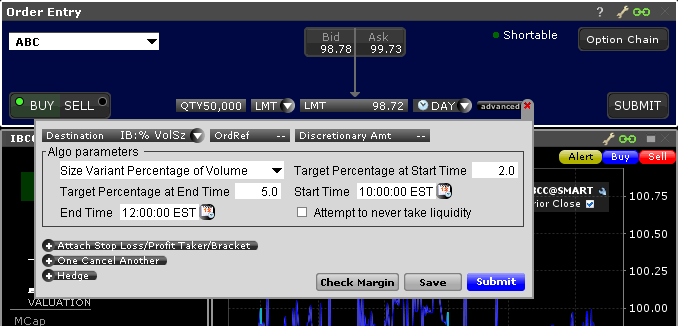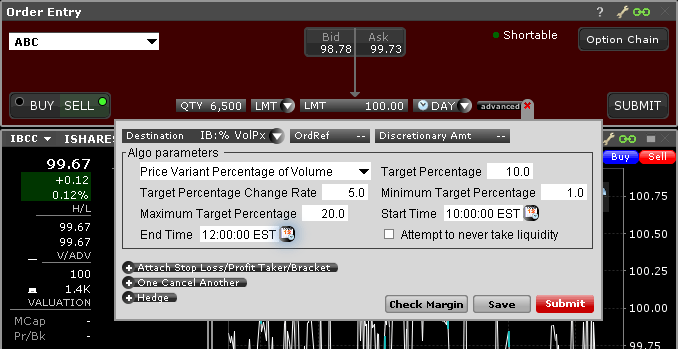Price Variant Percentage of Volume Strategy - This algo allows you to participate via volume
at a user-defined rate that varies over time based on the price of the security. This algo allows
you to buy more aggressively when the price is low and be more passive as the price increases,
and just the opposite for sell orders. The order quantity and volume distribution over the time
during which the order is active is determined using the target percent of volume you entered
along with continuously updated volume forecasts calculated from TWS market data.
Sell example
Variables:
Target Percentage – 10%
Minimum Target Percentage – 1%
Maximum Target Percentage – 20%
Target Percentage Change Rate – 5%
With ABC Corp. trading at $100.00 per share, an investor wants to sell 6,500 shares in total between 10:00am‐ 12:00pm. However, the investor wants to step up the pace of selling in the event that the share price strengthens. Conversely, he wants to ease off the selling pressure in the event the share price weakens.
Target Percentage 10.00% — Change Rate 5.00% — Min Participation Rate 1.00% — Max Max Participation Rate 20.00%
| Start Time |
End Time |
Price |
Percent Change In Price |
Participation Rate |
| 10:00 |
10:15 |
100.00 |
0.00% |
10.00% |
| 10:15 |
10:30 |
100.25 |
0.25% |
11.25% |
| 10:30 |
10:45 |
101.00 |
1.00% |
15.00% |
| 10:45 |
11:00 |
102.00 |
2.00% |
20.00% |
| 11:00 |
11:15 |
101.50 |
1.50% |
17.50% |
| 11:15 |
11:30 |
100.50 |
0.50% |
12.50% |
| 11:30 |
11:45 |
99.50 |
-0.50% |
7.50% |
| 11:45 |
12:00 |
99.00 |
-1.00% |
5.00% |
- As price increases the participation rate increases for a sell order
- If price falls the participation rate decreases for a sell order
The investor decides to participate at a pace of exactly 10% of ADV at the outset as shares are trading at $100.00 each.
He also sets the Target Percentage Change Rate to 5%. For every 1% increase (or $1.00 in this case) in
the value of ABC Corp. his pace of selling will increase by the amount entered in this field. For a sell
order, a 1% increase to $101.00 will step‐up his pace of selling from 10% to 15%. Should the share price
advance to $102.00 his participation rate will increase to comprise 20% of ADV.
Users can also add maximum and minimum values for target percentage rates. In this case, for example,
a 1% minimum target percentage rate would cause the algo to participate at 1% of ADV in the event the
share price falls to $98.00 and below. Likewise a 20% maximum target percentage rate would cause the
algo to never comprise more than 20% of ADV at any price above $102.00 during the timeframe input by
the user.
Buy example
Variables:
Target Percentage – 15%
Minimum Target Percentage – 6%
Maximum Target Percentage – 20%
Target Percentage Change Rate – 7%
In this example, the investor is a buyer of a large amount of ABC Corp. currently trading at $100.00 per
share. He wishes to buy more aggressively if the share price falls, but never wants to form more than
20% of ADV. The user sets the Target Percentage Participation rate at the outset to 15% and sets the
Change Rate to 7%. For each 1% change in the share price, the algo will vary the pace of participation by
7%. Although he has set the change rate to 7%, should the share price fall by 1% to $99.00 the algo
should accelerate the pace of buying to form 22% of ADV, but the investor has set a ceiling at 20% of
volume. Should the share price rise, the algo will ease off its buying pace, such that a 2% jump in the
share price ought to see participation slide to 1%. However, be entering a value for the Minimum Target
Participation rate ensures that the pace of buying remains at 6% of ADV regardless of the rise in the
share price.
Target Percentage 15.00% — Change Rate 7.00% — Min Participation Rate 6.00% — Max Max Participation Rate 20.00%
| Start Time |
End Time |
Price |
Percent Change In Price |
Participation Rate |
| 10:00 |
10:15 |
100.00 |
0.00% |
15.00% |
| 10:15 |
10:30 |
100.25 |
0.25% |
13.25% |
| 10:30 |
10:45 |
101.00 |
1.00% |
8.00% |
| 10:45 |
11:00 |
103.00 |
3.00% |
6.00% |
| 11:00 |
11:15 |
101.50 |
6.00% |
17.50% |
| 11:15 |
11:30 |
100.50 |
0.50% |
11.50% |
| 11:30 |
11:45 |
99.50 |
-0.50% |
18.50% |
| 11:45 |
12:00 |
99.00 |
-1.00% |
20.00% |
- As price increases the participation rate decreases for a buy order
- If price falls the participation rate increases for a buy order
The table explains that as the price increases by 0.25% during the first 15‐minutes, the participation falls
from its Target Percentage value of 15% to 13.25%. For a 1% rise in the share price the participation rate
dwindles to 8% having fallen by the value of the Change Rate. Note that by the time the share price has
risen by 3% to $103.00 the algo has reduced the purchase rate to the minimum allowed by the order
input of 6%. As the order progresses, a decline in the share price of 0.5% causes the participation rate to
advance back above the target to 18.5%. By the time the share price declines to $99.00 (‐1%) the algo
has accelerated the participation rate to its maximum value of 20% of ADV.





